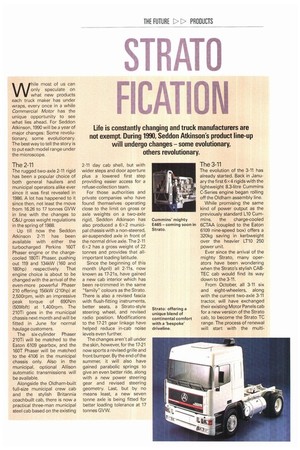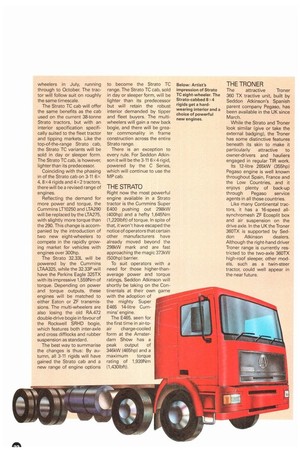STRATO FICATION
Page 143

Page 144

If you've noticed an error in this article please click here to report it so we can fix it.
Life is constantly changing and truck manufacturers are not exempt. During 1990, Seddon Atkinson's product line-up will undergo changes — some evolutionary, others revolutionary.
While most of us can only speculate on what new products each truck maker has under wraps, every once in a while Commercial Motor has the unique opportunity to see what lies ahead. For Seddon Atkinson, 1990 will be a year of major changes: Some revolutionary, some evolutionary. The best way to tell the story is to put each model range under the microscope.
The 2-11
The rugged two-axle 2-11 rigid has been a popular choice of both general hauliers and municipal operators alike ever since it was first revealed in 1986. A lot has happened to it since then, not least the move from 16.26 to 17 tonnes GVW in line with the changes to C&U gross weight regulations in the spring of 1988.
Up till now the Seddon Atkinson 2-11 has been available with either the turbocharged Perkins 160T Phaser engine or the chargecooled 180Ti Phaser, pushing out 119 and 134kW (160 and 180hp) respectively. That engine choice is about to be changed with the arrival of the even-more powerful Phaser 210 offering 156kW (210hp) at 2,500rpm, with an impressive peak torque of 690N m (509Ibft) at 1,400rpm. The 210Ti goes in the municipal chassis next month and will be fitted in June for normal haulage customers.
The six-cylinder Phaser 210Ti will be matched to the Eaton 6109 gearbox, and the 160T Phaser will be matched to the 4106 in the municipal chassis only. Also in the municipal, optional Allison automatic transmissions will be available.
Alongside the Oldham-built full-size municipal crew cab and the stylish Britannia coachbuilt cab, there is now a practical three-man municipal steel cab based on the existing 2-11 day cab shell, but with wider steps and door aperture plus a lowered first step providing easier access for a refuse-collection team.
For those authorities and private companies who have found themselves operating close to the limit on gross or axle weights on a two-axle rigid, Seddon Atkinson has also produced a 6 x 2 municipal chassis with a non-steered, air-suspended axle in front of the normal drive axle. The 2-11 6x2 has a gross weight of 22 tonnes and provides that allimportant loading latitude.
Since the beginning of this month (April) all 2-11s, now known as 17-21s, have gained a new cab interior which has been re-trimmed in the same "family" colours as the Strato. There is also a revised fascia with flush-fitting instruments, better seats, a Strato-style steering wheel, and revised radio position. Modifications to the 17-21 gear linkage have helped reduce in-cab noise levels even further.
The changes aren't all under the skin, however, for the 17-21 now sports a revised grille and front bumper. By the end of the summer, it will also have gained parabolic springs to give an even better ride, along with a new power steering gear and revised steering geometry. Last, but by no means least, a new seven tonne axle is being fitted for better loading tolerance at 17 tonnes GVW.
The 3-11
The evolution of the 3-11 has already started. Back in January the first 6 x4 rigids with the lightweight 8.3-litre Cummins C-Series engine began rolling off the Oldham assembly line.
While promising the same kind of power output as the previously standard L10 Cummins, the charge-cooled 6CTAA (coupled to the Eaton 6109 nine-speed box) offers a 320kg saving in kerbweight over the heavier LT10 250 power unit.
Ever since the arrival of the mighty Strato, many operators have been wondering when the Strato's stylish CABTEC cab would find its way down to the 3-11.
From October, all 3-11 six and eight-wheelers, along with the current two-axle 3-11 tractor, will have exchanged their existing Motor Panels cab for a new version of the Strato cab, to become the Strato IC range. The process of renewal will start with the multi wheelers in July, running through to October. The tractor will follow suit on roughly the same timescale.
The Strato TC cab will offer the same benefits as the cab used on the current 38-tonne Strata tractors, but with an interior specification specifically suited to the fleet tractor and tipping markets. Like the top-of-the-range Strato cab, the Strato TC variants will be sold in day or sleeper form. The Strato TC cab, is however, lighter than its predecessor.
Coinciding with the phasing in of the Strata cab on 3-11 6x 4, 8x4 rigids and 4x2 tractors, there will be a revised range of engines.
Reflecting the demand for more power and torque, the Cummins LT10250 and LTA290 will be replaced by the LTA275, with slightly more torque than the 290. This change is accompanied by the introduction of two new eight-wheelers to compete in the rapidly growing market for vehicles with engines over 300hp.
The Strata 32.33L will be powered by the Cummins LTAA325, while the 32.33P will have the Perkins Eagle 325TX with its impressive 1,559Nm of torque. Depending on power and torque outputs, these engines will be matched to either Eaton or ZF transmissions. The multi-wheelers are also losing the old RA.472 double-drive bogie in favour of the Rockwell SRHD bogie, which features both inter-axle and cross difflocks and rubber suspension as standard.
The best way to summarise the changes is thus: By autumn, all 3-11 rigids will have gained the Strata cab and a new range of engine options to become the Strata TC range. The Strata TC cab, sold in day or sleeper form, will be lighter than its predecessor but will retain the robust interior demanded by tipper and fleet buyers. The multiwheelers will gain a new back bogie, and there will be greater commonality in frame construction across the entire Strato range.
There is an exception to every rule. For Seddon Atkinson it will be the 3-11 6x4 rigid, powered by the C Series, which will continue to use the MP cab.
THE STRATO
Right now the most powerful engine available in a Strata tractor is the Cummins Super E400 pushing out 298kW (400hp) and a hefty 1,645Nm (1,220Ibft) of torque. In spite of that, it won't have escaped the notice of operators that certain other manufacturers have already moved beyond the 298kW mark and are fast approaching the magic 373kW (500hp) barrier.
To suit operators with a need for those higher-thanaverage power and torque ratings, Seddon Atkinson will shortly be taking on the Continentals at their own game with the adoption of the mighty Super E465 14-litre Cummins' engine.
The E465, seen for the first time in air-to air charge-cooled form at the Amsterdam Show has a peak output of 346kW (465hp) and a maximum torque rating of 1,939Nm (1,4301bff).
THE IRONER
The attractive Troner 360 TX tractive unit, built by Seddon Atkinson's Spanish parent company Pegaso, has been available in the UK since March.
While the Strato and Troner look similar (give or take the external badging), the Troner has some distinctive features beneath its skin to make it particularly attractive to owner-drivers and hauliers engaged in regular TIR work.
Its 12-litre 265kW (355hp) Pegaso engine is well known throughout Spain, France and the Low Countries, and it enjoys plenty of back-up through Pegaso service agents in all those countries.
Like many Continental tractors, it has a 16-speed allsynchromesh ZF Ecosplit box and air suspension on the drive axle. In the UK the Troner 360TX is supported by Sed don Atkinson dealers. Although the right-hand driver Troner range is currently restricted to the two-axle 360TX high-roof sleeper, other models, such as a twin-steer tractor, could well appear in the near future.
























































































































































